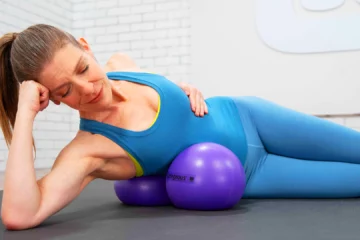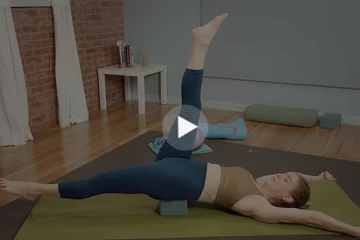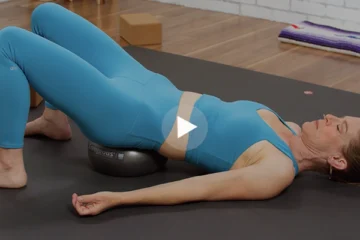
SCENE: A yoga class. Students are standing in Mountain Pose like a Buddhist “army.”
Teacher: Breathe in…
Class: (A subtle, yet audible “sucking” sound is heard.)
Teacher: And breathe out…
Class: (A subtle, yet audible “whooshing” sound is heard.)
Teacher: Good. Now three more deep breaths just like that.
Class: (They are audibly compliant until…)
Teacher: Now step your right foot back.
Class: (The sound of 25 left feet strike the pose, and no more breathing is heard.)
Teacher: What, no more breathing? Let every movement be a prompt to remind you to breathe for the next 90 minutes.
Class: (Sound of breathing is amplified again, and class proceeds smoothly until … well, the class forgets to breathe again. And again. And again sporadically throughout the class.)
What’s going on here? Why do so many of us forget to breathe? Did you actually finish breathing?
It seems laughable, the notion of “finishing breathing.” Our nervous systems are actually built in such away that breath happens automatically, without us prompting our breathing muscles every few seconds. Think about it, a lot of mental energy is actually required to control every single breath (instead of letting it happen on its own), and our brains have a zillion other tasks to balance. But the breezy thing about breathing is that we can control it, and in so doing we can deliberately impact every system of the body.
The yoga students above were doing just fine until they moved their legs. That leg movement siphoned off their concentration on breathing. It’s the old “doing two things at once” phenomenon. Once the grand motor movement of the sympathetic nervous system was issued to the legs, the poor breathing muscles, especially the diaphragm, switched back over to an undercover operative, relying on the automatic signaling from the brain to remind the body to breathe. That is until the teacher reminded the students to resuscitate themselves again.
Pranayama: Holding your breath with your mind.
So even if you do forget to “finish a breath,” meaning your conscious mind flipped from willing motor control to operating on automatic, the good news is that your unconscious mind was NOT finished breathing yet! Your body is so smart, and it loves finding homeostatic balance all the time. WHEW!
The yogis are famous for their controlled breathing practices called “pranayama.” Pranayama also translates to extension of energy. You can easily feel how your entire internal ecosystem shifts gears dramatically depending on how you choose to breathe. Overall, when you influence that length, size, volume and style of your breath, it changes your whole body’s operating system. This can either excite your whole body, or sedate it.
One of the signs of an advanced practitioner is that you’ve narrowed the distance between:
- forgetting to breathe consciously
- realizing that you’ve forgotten to breathe
- then quickly kick-starting conscious breathing again.
In other words, your awareness is so sharp between breaths that the gaps between conscious and unconscious breathing become smaller and smaller.
The undercover abdominal muscle – Get to know it from start to finish

Your biggest player in your breathing underworld is the respiratory diaphragm. It is the prime mover in breathing and its thorough contraction and relaxation dominate the filling and emptying of your lungs (there are other players too, but I am writing a blog here, not a chapter). It’s shaped like an internal parachute and lines the insides of your lower six ribs.
Getting to know your diaphragm is as easy as having the hiccups. When you hiccup (also an unconscious muscle behavior) the diaphragm is in little mini-spasms. One of the “cures for hiccups” (according to my husband) is to take the biggest balloon-style belly breath you can muster and hold your breath for as long as you can. This is actually a conscious and sustained contraction of the diaphragm, and it will often turn off the hiccup reflex. I suppose if a sustained contraction of the muscle will turn off the hiccups, then the opposite might also be true of a sustained stretch of the diaphragm.

You’ll find a detailed exercise for this called “Uddiyana Bandha” here, or watch this video version I created with my physical therapist friend, Kelly Starrett, mastermind behind San Francisco CrossFit and Mobilitywod.com.
Please let me know if my hiccup theory works for you! And for loads of additional pranayamas and core-related conditioning, check out my new Coregeous DVD or try my Yoga for Weight Loss video on GaiamTV.com.
And remember: Don’t be caught dead not breathing!
[Reprinted with permission from GaiamLife]
Learn about our stress relief products.
Watch our stress relief videos instantly.












The hiccup reference is great because it’s so difficult to identify where the diaphragm is. Even just faking a couple of hiccups brings your awareness directly to the muscle and gives you a sense of what it’s up to. I’ll use this trick to help students understand their body mechanics before getting into deep breathing exercises.
There are definitely some movements where I feel I MUST breathe a certain way – twists, for example, are always much deeper if I practice thoracic instead of abdominal breathing, and exhaling into a twist allows for a deeper expression of the pose. But Jill is completely right – we’re not finished breathing in a class, but we can definitely be more mindful of it. Autonomic processes are amazing, but so is pranayama!
Such a funny thing…forgetting to breath. I’ve gone through several periods of my life where it feels that my body has forgotten how to breath. The oxygen cuts off below my nose and never reaches my brain…..Creating feelings of panic and exhaustion. This most recently happened for a period while I was living in India. Thankfully I found a doctor who taught Pranayama, who gave me some basic techniques when having this experience. So much to learn about the human body..
Ok this is great! I love the intro – you are so right and we really need to focus on more breath work throughout classes. Most people think they breath evenly all the way through but how you started your article is a perfect example of starting on the right foot and not continuing.
“That leg movement siphoned off their concentration on breathing.” I love the image this creates because to me it’s exactly how it happens. Standing in mountain pose, it’s easy, or at least easier, to put more focus on breath. But then all the moving parts come in and it becomes a free for all. At least that’s how it felt in the very beginning for me – I’d like to believe I’ve made some progress here. But even now, depending on what kind of day I’m having with work, or family, or girlfriend, or whatever else is out there, my breathing may be on point or all over the map. I guess this is part of the reason many of us prefer practicing with a teacher more than doing it on our own. Not only for the physical poses and form, but also because of that gentle reminder to keep fluid breath coming and going.
Also, just as a side note to your last point, I’ve always found that for me the best way to get rid of hiccups is blowing all of the year I possibly can from my lungs and then holding.
Love the way you explain this. It’s all about awareness I guess!
When we are doing WODS at CrossFit NCR, we put a huge emphasis on conscious breathing during the movements and especially during transitions. It is a huge part of success in the gym, being aware of the breath. It allows you to stay focused on the task at hand and get as much oxygen to the muscles as possible during strenuous activity.
What a perfect recap! We just reviewed this topic with Sarah Court during our first night of YTUIA. Thank you!
Some of my favorite teachers cue almost every movement with breath. Because of them there are some asanas I can’t imagine doing without breathing. After taking YTU and learning about the different abodes of breath, I now feel comfortable that when I’m in a pose where I’m restricting my breath, I can consider which breath would suit me best.
Pranayama is an extension of energy. I love this statement. My practice of yoga started many years ago and when one of my teachers explained the practice of breathing my practice improved tremendously. Consciously breathing while moving the body, what a concept!
The art of breathing is not always addressed in classes and I believe it should be emphasized not only in yoga but other fitness classes and exercises.
This is great! As I teach restorative, where movement isn’t exactly at the top of the “what to do in class” list, it becomes of vital importance to remind students to breath. Our brains have about a 4 breath attention span so even the most diligent pranayama practicer can loose site of their breath after 4 good inhales. With movement, and expecially without, breath is so vital to yoga practice. Thanks!
This was a great article.. I am constantly reminded to breathe because I become light headed. I thought I was just airfailry… Apparently not :0)
Thank you Jill. I am REALLY enjoying getting into my belly with the coregeous video. As an opera singer, slide and glide in the muscles of the “coreso” and elastic strength is vital to my ability to sing. I have definitely noticed myself breathing on “autopilot” during a yoga practice and I’m sure that it happens in a restricted cage if I have not done the work prior to the practice in order to loosen up the tissue in the belly and chest. I was scared to get back into belly ball work because of having internal bleeding last year when I worked on it (NOT from Yoga Tune Up or with your videos)….but I feel REALLY amazing and my belly travelled from scared to Soooooo happy. Peace to you.
First, I am really curious to see if that cure for the hiccups really work, so thanks in advance for the tip if it does. Secondly, it’s a wonderful feeling when you are able to truly breathe when moving in a flow, it induces relaxation, calms the mind, like your breath is dancing with your body.
This post reminded me when I just started to practice yoga. I was so focused on the pose not to breath, as soon as the instructor address the next pose, my mind is too busy moving your limbs!! not even engaging the core either. Over time, more I got to know about yoga, I started to focus on breathing and mindfulness so I can relax my body in the challenging poses!
I am so glad to have come across this! I just had one of my students email me and ask me if I could help her breathe better- she was told by her Dr she doesn’t completely exhale. And her I am at the YTU training! I will save this blog, as well as study hard to be available for her when I get home!
This was a great video for me, as I often stop breathing in stressful situations. I’m not aware of it and it is typically apparent to the outside would before I remember to take my next inhale…strange really. By really focusing on ‘a way’ to breath, I think I can mitigate these situations! Thanks!
Jill, thanks for this reminder to breathe! You reminded me of sitting beside my 79 year old father in the car…. As I drove, I listened to his breath, he would talk, take some very shallow breaths, then after his body felt starved for breath, he then took… Almost a sigh to get enough breath to continue.
Our bodies regulate the breath that we need, sometimes it takes a gentle reminder (from a daughter) that we need to slow down and take a deep breath and relax!
One of the key things I focus on with my Seniors Yoga class from week to week is breathing. We do alot of work on various things like standing well on two feet, learning to balance well on one foot, and how they walk, but breath is the single most extraordinary tool I think I can give them. These are people in their 60s and 70s and 80s who for the first time are saying, ‘oh my god, I have so much more breath in me than I thought’, or at least in their own words that’s what their saying. I always tell them that it sounds like there’s a vacuum in the room when the stop breathing, as they focus on their balance or where to put their hands and then you can hear the gush of air come back into the space. People forget they can breath or that they do breath. I forget – in fact I just had to check in on myself as I type this, make sure I wasn’t holding my breath in concentration. So excited to teach YogaTuneUp to all my classes, but in particular am already seeing how I can re-shape the Seniors class. Thank you!
Catching up on my diaphragm research. Thank you Jill for continuing to fuel my obsession with the STRUCTURAL importance of the diaphragm. “Armoring” myself for life.
[…] of awareness, surgeries and time, moving through fear is an essential element of my teaching. Breathing through intimidation, and strange new sensations becomes a major tool to beginning a practice with […]
[…] is perhaps one of the most important keys to exploring the practice. Ujayii breath is one of many breathing techniques used in yoga — and I recommend you try it for stress relief and mind-body health even if you’re not a […]
Pranayama and the different types of breathing has probably been one of the most influential things I’ve learned during TT. Not only while practicing yoga, but also during my everyday life. Work and general NYC life can create some anxiety for me, and whenever I feel it coming on, I more and more turn to my breath without even mentally deciding to. Learning about breath has also been extremely helpful in improving my yoga practice, physically and mentally. I am now able to to do many poses I couldn’t before, just by knowing, “Oh since I’m in wheel, I should be focusing on thoracic breathing,” instead of not breathing at all, feeling anxious and bailing on the pose. Counting my breath has also been a great meditative practice.
It is true that as a yoga student we only really think of breathing when our teacher tells us to. And then we seem to forget when we are concentrating on the poses. This will be a good thing to watch out for when I start teaching yoga and helping my future students find their breath while in the pose and to be really connected to it.
Pranayama relaxes my mind and I always felt that it has a soothing effect on my body too. In some pranayama I tend to over breath and sometimes I tend to go out breath too specially in rechaka while holding the breath for sixteen counts in anulom vilom. But uddiyana bandha has always acted as a great breath purufier. This vaccum exercise totally uplifts my energy level. I always take this breathing practice one notch higher by practicing nauli kriya. They are complementory to each other and both of them are great core strengthener.
Thank you not only for the reminder to breathe but also scientific/practical information applied in a yoga context as to why it happens.
I suffer from anxiety and since doing yoga and taking the YTU TT Level 1, I’ve starting to make so many connections with things like the breath, the rib cage, the diaphragm, the emotions, the confidence, and slowly the nervous system that would relate to the signs and symptoms of the anxiety and understanding what’s happening to my body. I found during the training in Toronto at the end of September, having a sankalpa is definetely handy! 🙂 Plus doing any form of yoga really, having those various types of breathing techniques.
Jill, your husband’s hiccup theory works!! At least it has for me for years. I will have hicups almost every single day – and generally it’s more than once! – and when this happens, it’s the first thing I do. I have often been told to drink water as well. I have not found that this technique works as well. As a matter of fact, often it doesn’t do anything at all. Anyone know if this really works and if so why it may not work for certain people?
As a yoga teacher I am constantly reminding my students that it is all about the breath! I knew this, I know this, I am still learning this more and more each day! Of course without breath we would not be alive… however.I mean on a deeper level….an energitic level….a cellular level….a spiritual level… yes.every level….it is all about the breath.
I love the visual of a parachute! I try to always remember when I am practicing that it is about the breath. I went through a period when I would sit down during class everytime I lost the breath to reconnect, knowing that the breath should never be compromised for any pose. As my practice has grown as a student and a teacher I cherish the union of breath and movement.
I let the breath inform me when it is time to move the body. In other words, my movement rides on the wave of my breath. This feels wonderful and allows for a deeper, fuller exchange of air and energy with the added benefit of a wider range of motion.
BTW – my cure for hiccups is drinking water out of a glass backwards (forward flexion) Go Figure!
I used to suffer a lot from hiccups and used the breath holding method and it works!
The breath is so tricky! I’m still learning the many variations of yogic breathing. I find it easier (and more exciting) to do an inversion like headstand than deep belly breathing. Why is that? I find it easier to take deeper breaths in my thoracic adobe rather than my abdominal adobe. It’s a form I still haven’t learned to control, and clearly, need a lot of practice.
When I began yoga, I would totally forget to align the breath with the pose and consequently found myself out of breath or lightheaded numerous times. By slowing down and listening to the cues of the teacher in the beginning and then gradually my own inner cues, I found my practice moving to a whole new level. Likewise, this is a lesson to take off the mat and remember to breathe when something distracts your focus, very profound lesson and a very valuable one.
As I go forward with yoga and try different class types every now and then I find my self not breathing, oh until someone says take a deep breath. I am slowly learning how important it is to not only watch what yoga pose I am in but am I still breathing!
I took the first day of a Yoga Tune Up module today and learned something that I wished all yoga teachers would simply explain in classes: that there is abdominal breathing, thoracic breathing, and clavicular breathing. I have had quite a lot of “feel the breath fill your abdomen, then your lower chest, and upper chest”…actually just a simple understanding of my anatomy, where the diaphragm is, how it works, what’s below and above it, helped me to join the breath with some of the asanas I practiced tonight and not to lose it when I was shifting positions. That was like an instant improvement. Thank you for that.
I think we sometimes forget to breathe because right before that step back, our instructor is guiding us on each individual inhale and exhale. We appear to get lost in listening to their words and doing exactly as they say. It’s funny as automatic as breathing is for us, outside of practice.
I forget to breath often during my yoga practice. Thankfully I have teacher’s who remind me to be mindful of my breathing and to practice “Pranayama”-Breathing regularly.
What really grasped my attention in this blog was:
“One of the signs of an advanced practitioner is that you’ve narrowed the distance between: forgetting to breathe consciously realizing that you’ve forgotten to breathe then quickly kick-starting conscious breathing again.” -Jill Miller
I can so relate to this! It is the story of my Yoga life lol. I want to be able to consciously have controlled breathing through my yoga practice. I know that it will take time but I am definitely willing to mindfully practice.
Thank you!
As a teacher in training, I am flooded with fantastic information, words in sanskrit, phylisophical and anatomical language. Honestly, a lot of these terms I will forget, however your article reiterates how teaching and reminding your students to do the simplest thing (breathe), doesn’t need fancy words around it, it just needs to be said. Deep breathing has aided me through some difficult situations and is such an important part of my practice and life.
When I stared yoga, I used to stop breathing. This blog reminds me that breath is most important relative to yoga.
I just keep repeating “I am a student of my body” I hate breathing, I honestly wouldn’t breathe if I didn’t have to. Years of contraction have made it sometimes painful, emotional, impossible to breathe. Thank you for this article! I know I’m not the only one that needs to be reminded to breathe.
‘Excellent’ Article. Completely relatable scenarios with the class and the hiccups, I was smileing whilst reading – cool.
For me, it is auspicious to be in that place of awareness, due to diligence of yogic practices, where you ARE aware of the breath almost at all times and all states. It’s almost as if you’re on the outside in observance of yourself, your body. I like to remind people around me, “You know we’re HERE because of the body; and this is why it’s SO important to take care of it as long as we want to be here and have quality of life!” I’m going to add: “Crucial to our staying alive, health, and quality of life and emotional state is; not only the heart, but, the little talked about, DIAPHRAGM!”
Silvia Marisol
Like these students, we’ve all felt ourselves “not breathing” or “not centered” when faced with a challenge. This blog is a great reminder of how benefical practising controlled breathing can be. It will enable us to better access our breath when we need it most, doing exercises, giving a presentation or performing infront of others, or in a job interview.